Pages 44-47
by Academician Iqrar Aliyev
Gandzasar Monastery, which includes the famous Gandzasar Cathedral (now in Agdere District in Azerbaijan) is a masterpiece of medieval Albanian architecture. It is a unique structure even when compared to Armenian architecture. The monastery was built during the Albanian Renaissance in the 13th century, in historically Azerbaijani land, in an important province of ancient and early medieval Albania - Artsakh - which covered present-day Mountainous Karabakh and part of the Mil plain.
To understand the environment in which Gandzasar was built and the needs of the community it served, we shall have a brief look at the history of Artsakh province.
Artsakh consisted of 12 small administrative units. Contrary to the opinion of Armenian scholars, who say that the population of Artsakh was primarily Armenian, all sources show that during late antiquity and the early Middle Ages the population of Artsakh consisted of indigenous Albanian tribes including the Udis, Gargars, Caspis and Tsods and the incoming tribes of the Sils and Khazar (Herodotus, M. Khorensky, F. Buzand, M. Kalankatuyskiy etc.). The language of the indigenous Albanians belongs to the North Caucasian (Nakh-Dagestani) language group.
In the 1st to 6th centuries Artsakhwas ruled by the Albanian kings, the Arshakids and in the 7th to the 8th centuries by the Albanian grand princes, the Mikhranids. Artsakh had very significant political and church influence in Albania. Artsakh clergy together with the secular aristocracy participated in all Albanian church cathedrals, but not Armenian ones. Many patriarchs of Albania were selected from the Artsakh clergy. In the 8th century the Albanian kingdom fell to the Arabian conquest. The lowland part of Albania and the valleys of the Kur and Araz rivers were occupied by the Arabs. As a result the population of the lowland areas became Islamized and merged further with the Turkic-speaking population of the country. However, the highland parts of Artsakh remained under the control of the Albanian princes, the Mikhranids.
In the 9th century a descendant of Varaz-Trdata, Albanian Prince Grigory Hamam, partly restored the crushed Albanian empire, which included Artsakh. After his death, Hamam´s son Saak Sevada took possession of Artsakh and the province of Udi and ruled for many years. The Khachin Princedom emerged in Artsakh in the 12th-13th centuries, described by Academician I.A. Orbeli as "part of ancient Albania". The centre of Artsakh-Khachin was the basin of the Khachinchay River and part of the Terterchay basin.
Hasan Jalal (1215-61) became governor of the Artsakh-Khachin Princedom. He was also a descendant of the Albanian Mikhranids and could trace his genealogy back to them. Hasan Jalal was the sovereign prince of Khachin and part of Artsakh and was a vassal neither of the Georgian empire nor the Armenian Zakaryan princedom. Armenian, Georgian and Persian sources of the period and epigraphic inscriptions give Hasan Jalal high titles such as "Prince of Princes", "Regal - Splendid", "Prince of the Khachin Countries", "Grand Prince of the Khachin and Artsakh Countries", "Emperor", "Wearer of the Crown", "Emperor of Albania" and "Great Holder of the Marches of Albania". Hasan Jalal called himself emperor and autocrat.
The most magnificent title is found on a 1240 inscription in Gandzasar Monastery: "I, God´s humble slave Hasan Jalal, son of Vakhtang, the grandson of great Hasan, the lawful autocratic emperor of the high and great country Artsakh which has extensive lands". Hasan Jalal´s father, Vakhtang, was descended from the Albanian Mikhranids and his mother, Horishah, was a sister of the well-known Ivan and Zakar Mkhargrdzely, of Kurdish origin. Hasan Jalal´s wife Mamkan was from the family of the Syunik ruler Senekerim who, in turn, was also a descendant of the Albanian Mikhranids. Hasan Jalal´s ties of kinship with the influential houses of the era are a clear sign of the high standing of the ruler of Khachin-Artsakh.
Hasan Jalal´s rule can be considered a period of economic, political and cultural revival in Albania. This rise was reflected in literature, civil engineering and architecture and in particular in church building. This was when Moisey Kalankatuyskiy wrote four new chapters of his Albanian History which covered Hasan Jalal´s rule and his construction of the Gandzasar complex. This represented a revival of the Albanian historic-literary tradition, but unlike in the past it used the Old Armenian language. Hasan Jalal won the favour of the Mongolian khans towards the house of Albania and its people, who saw themselves as inhabitants of Albania with an Albanian identity, but who had already undergone a long process of Gregorianisation and Armenianisation. In the 13th century the population of the Artsakh-Khachin Princedom spoke and wrote in two languages, Albanian (Aran) and old Armenian, while thepopulation of the former Albanian lowlands wrote and spoke Aran, Arabic and Persian but were nevertheless ethnically neither Arab, nor Persian. Language was not the only indicator of ethnic origin. The modern French, English, Portuguese and Egyptians did not speak in their old languages either.
Gandzasar Monastery was built by Hasan Jalal. An older Gandzasar monastery existed at the site long before Hasan Jalal and held the ancestral tomb of the Khachin rulers – the Jalalids. Hasan Jalal was buried in this tomb. From 1216 to 1238 Hasan Jalal built Gandzasar Cathedral at the insistence of the Albanian patriarch, Nerses, who called it the "eparchal cathedral of Albania" but not of Armenia. Almost all the patriarchcatholicoses of the later Albanian period were buried in Gandzasar. This can be seen from the epigraphs on tombstones, dated up to 1828.
Hasan Jalal´s descendants, the Jalalids, ruled Khachin until the 15th century. After they lost secular political authority, the Jalalids became the spiritual rulers of the country. They were the patriarch-catholicoses of the Albanian independent church until 1836 when the Albanian Church was abolished and subordinated to the Armenian Church. If, as a significant number of Armenian authors have recently claimed, Gandzasar was an Armenian church, then why did the Holy Synod have to issue a special rescript in 1836 on making Gandzasar part of the Armenian Church? The historical Albanian province of Artsakh, where Gandzasar Monastery was built in the 13th century, was until the 19th century a significant political, cultural and spiritual centre for the Albanian Christian population, who managed to maintain their territorial, political and confessional unity and their Albanian identity even though they were subject to Armenianisation until the 19th century.
Therefore, the attempts of Armenian Catholicos Vazgen I and Armenian academics to say that Gandzasar Monastery is Armenian and was built in an Armenian area and Armenian ethnic environment are completely groundless and wrong. Besides, it is perfectly clear that there cannot be two independent patriarchates, two independent churches, in one ethnic environment. Representatives of the Armenian Catholicos, such as Academician V.A. Ambartsumyan, Silva Kaputikyan, B. Ulubabyan and others visited Gandzasar Cathedral and tried to persuade the population of Vanklu village that they were the descendants of Armenians, not Albanians. Meanwhile, descendants of Hasan Jalal live in the village and remember their roots and know that their ancestors were Udis-Albanians.
As Prof. I.P. Petrushevskiy said, "Karabakh (Artsakh) was never a centre of Armenian culture."
Academician Iqrar Aliyev (1924-2004) directed the National Academy of Science of Azerbaijan’s A.A.Bakikhanov History Institute from 1978 to 2004.
by Academician Iqrar Aliyev
Gandzasar Monastery, which includes the famous Gandzasar Cathedral (now in Agdere District in Azerbaijan) is a masterpiece of medieval Albanian architecture. It is a unique structure even when compared to Armenian architecture. The monastery was built during the Albanian Renaissance in the 13th century, in historically Azerbaijani land, in an important province of ancient and early medieval Albania - Artsakh - which covered present-day Mountainous Karabakh and part of the Mil plain.
To understand the environment in which Gandzasar was built and the needs of the community it served, we shall have a brief look at the history of Artsakh province.
Artsakh consisted of 12 small administrative units. Contrary to the opinion of Armenian scholars, who say that the population of Artsakh was primarily Armenian, all sources show that during late antiquity and the early Middle Ages the population of Artsakh consisted of indigenous Albanian tribes including the Udis, Gargars, Caspis and Tsods and the incoming tribes of the Sils and Khazar (Herodotus, M. Khorensky, F. Buzand, M. Kalankatuyskiy etc.). The language of the indigenous Albanians belongs to the North Caucasian (Nakh-Dagestani) language group.
In the 1st to 6th centuries Artsakhwas ruled by the Albanian kings, the Arshakids and in the 7th to the 8th centuries by the Albanian grand princes, the Mikhranids. Artsakh had very significant political and church influence in Albania. Artsakh clergy together with the secular aristocracy participated in all Albanian church cathedrals, but not Armenian ones. Many patriarchs of Albania were selected from the Artsakh clergy. In the 8th century the Albanian kingdom fell to the Arabian conquest. The lowland part of Albania and the valleys of the Kur and Araz rivers were occupied by the Arabs. As a result the population of the lowland areas became Islamized and merged further with the Turkic-speaking population of the country. However, the highland parts of Artsakh remained under the control of the Albanian princes, the Mikhranids.
In the 9th century a descendant of Varaz-Trdata, Albanian Prince Grigory Hamam, partly restored the crushed Albanian empire, which included Artsakh. After his death, Hamam´s son Saak Sevada took possession of Artsakh and the province of Udi and ruled for many years. The Khachin Princedom emerged in Artsakh in the 12th-13th centuries, described by Academician I.A. Orbeli as "part of ancient Albania". The centre of Artsakh-Khachin was the basin of the Khachinchay River and part of the Terterchay basin.
Hasan Jalal (1215-61) became governor of the Artsakh-Khachin Princedom. He was also a descendant of the Albanian Mikhranids and could trace his genealogy back to them. Hasan Jalal was the sovereign prince of Khachin and part of Artsakh and was a vassal neither of the Georgian empire nor the Armenian Zakaryan princedom. Armenian, Georgian and Persian sources of the period and epigraphic inscriptions give Hasan Jalal high titles such as "Prince of Princes", "Regal - Splendid", "Prince of the Khachin Countries", "Grand Prince of the Khachin and Artsakh Countries", "Emperor", "Wearer of the Crown", "Emperor of Albania" and "Great Holder of the Marches of Albania". Hasan Jalal called himself emperor and autocrat.
The most magnificent title is found on a 1240 inscription in Gandzasar Monastery: "I, God´s humble slave Hasan Jalal, son of Vakhtang, the grandson of great Hasan, the lawful autocratic emperor of the high and great country Artsakh which has extensive lands". Hasan Jalal´s father, Vakhtang, was descended from the Albanian Mikhranids and his mother, Horishah, was a sister of the well-known Ivan and Zakar Mkhargrdzely, of Kurdish origin. Hasan Jalal´s wife Mamkan was from the family of the Syunik ruler Senekerim who, in turn, was also a descendant of the Albanian Mikhranids. Hasan Jalal´s ties of kinship with the influential houses of the era are a clear sign of the high standing of the ruler of Khachin-Artsakh.
Hasan Jalal´s rule can be considered a period of economic, political and cultural revival in Albania. This rise was reflected in literature, civil engineering and architecture and in particular in church building. This was when Moisey Kalankatuyskiy wrote four new chapters of his Albanian History which covered Hasan Jalal´s rule and his construction of the Gandzasar complex. This represented a revival of the Albanian historic-literary tradition, but unlike in the past it used the Old Armenian language. Hasan Jalal won the favour of the Mongolian khans towards the house of Albania and its people, who saw themselves as inhabitants of Albania with an Albanian identity, but who had already undergone a long process of Gregorianisation and Armenianisation. In the 13th century the population of the Artsakh-Khachin Princedom spoke and wrote in two languages, Albanian (Aran) and old Armenian, while thepopulation of the former Albanian lowlands wrote and spoke Aran, Arabic and Persian but were nevertheless ethnically neither Arab, nor Persian. Language was not the only indicator of ethnic origin. The modern French, English, Portuguese and Egyptians did not speak in their old languages either.
Gandzasar Monastery was built by Hasan Jalal. An older Gandzasar monastery existed at the site long before Hasan Jalal and held the ancestral tomb of the Khachin rulers – the Jalalids. Hasan Jalal was buried in this tomb. From 1216 to 1238 Hasan Jalal built Gandzasar Cathedral at the insistence of the Albanian patriarch, Nerses, who called it the "eparchal cathedral of Albania" but not of Armenia. Almost all the patriarchcatholicoses of the later Albanian period were buried in Gandzasar. This can be seen from the epigraphs on tombstones, dated up to 1828.
Hasan Jalal´s descendants, the Jalalids, ruled Khachin until the 15th century. After they lost secular political authority, the Jalalids became the spiritual rulers of the country. They were the patriarch-catholicoses of the Albanian independent church until 1836 when the Albanian Church was abolished and subordinated to the Armenian Church. If, as a significant number of Armenian authors have recently claimed, Gandzasar was an Armenian church, then why did the Holy Synod have to issue a special rescript in 1836 on making Gandzasar part of the Armenian Church? The historical Albanian province of Artsakh, where Gandzasar Monastery was built in the 13th century, was until the 19th century a significant political, cultural and spiritual centre for the Albanian Christian population, who managed to maintain their territorial, political and confessional unity and their Albanian identity even though they were subject to Armenianisation until the 19th century.
Therefore, the attempts of Armenian Catholicos Vazgen I and Armenian academics to say that Gandzasar Monastery is Armenian and was built in an Armenian area and Armenian ethnic environment are completely groundless and wrong. Besides, it is perfectly clear that there cannot be two independent patriarchates, two independent churches, in one ethnic environment. Representatives of the Armenian Catholicos, such as Academician V.A. Ambartsumyan, Silva Kaputikyan, B. Ulubabyan and others visited Gandzasar Cathedral and tried to persuade the population of Vanklu village that they were the descendants of Armenians, not Albanians. Meanwhile, descendants of Hasan Jalal live in the village and remember their roots and know that their ancestors were Udis-Albanians.
As Prof. I.P. Petrushevskiy said, "Karabakh (Artsakh) was never a centre of Armenian culture."
Academician Iqrar Aliyev (1924-2004) directed the National Academy of Science of Azerbaijan’s A.A.Bakikhanov History Institute from 1978 to 2004.
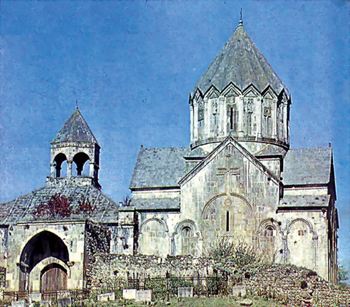
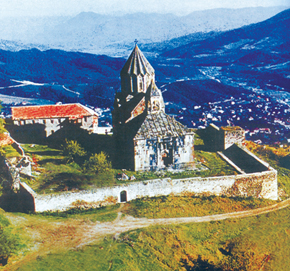
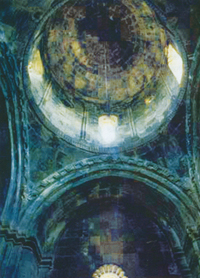
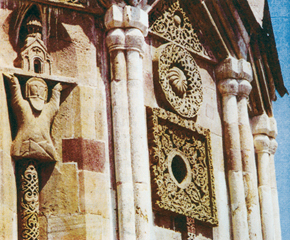
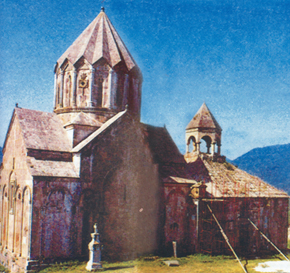
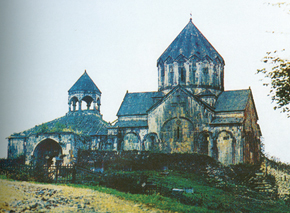


.jpg)